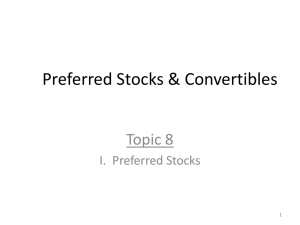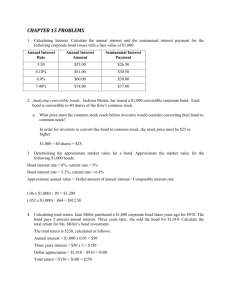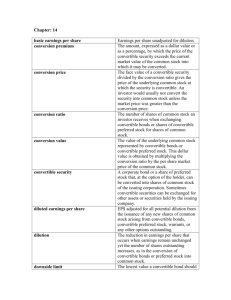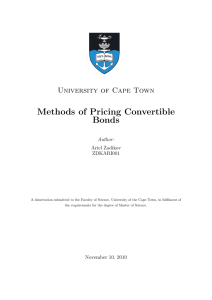Hedge and Trade Convertible Bonds Worksheet
advertisement
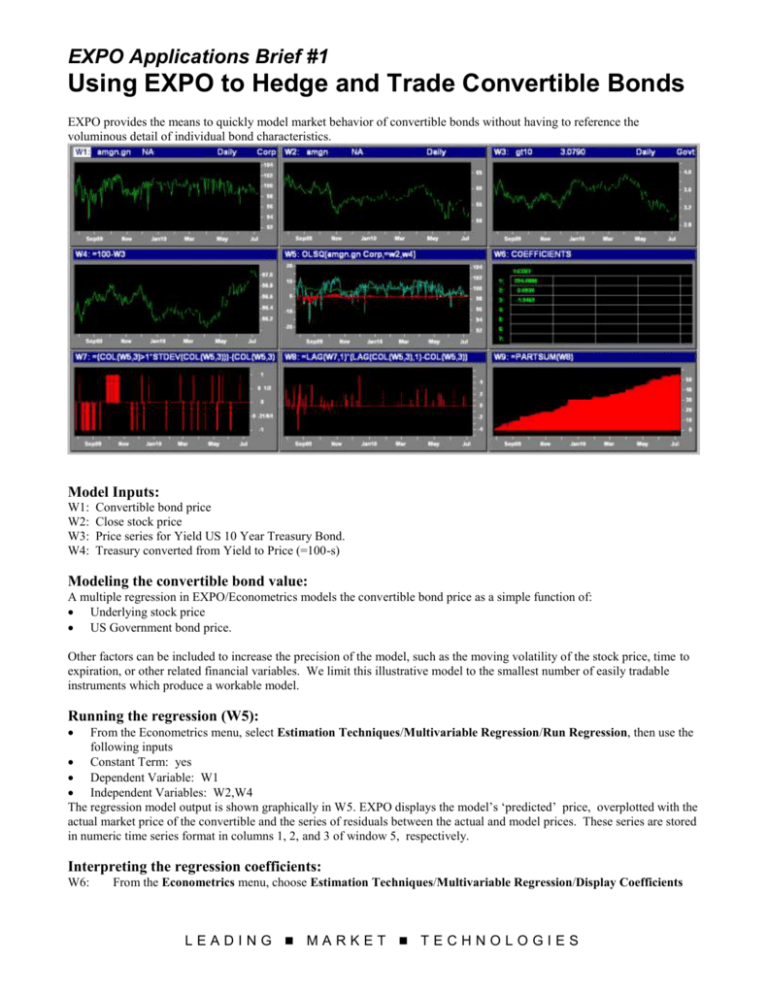
EXPO Applications Brief #1 Using EXPO to Hedge and Trade Convertible Bonds EXPO provides the means to quickly model market behavior of convertible bonds without having to reference the voluminous detail of individual bond characteristics. Model Inputs: W1: W2: W3: W4: Convertible bond price Close stock price Price series for Yield US 10 Year Treasury Bond. Treasury converted from Yield to Price (=100-s) Modeling the convertible bond value: A multiple regression in EXPO/Econometrics models the convertible bond price as a simple function of: Underlying stock price US Government bond price. Other factors can be included to increase the precision of the model, such as the moving volatility of the stock price, time to expiration, or other related financial variables. We limit this illustrative model to the smallest number of easily tradable instruments which produce a workable model. Running the regression (W5): From the Econometrics menu, select Estimation Techniques/Multivariable Regression/Run Regression, then use the following inputs Constant Term: yes Dependent Variable: W1 Independent Variables: W2,W4 The regression model output is shown graphically in W5. EXPO displays the model’s ‘predicted’ price, overplotted with the actual market price of the convertible and the series of residuals between the actual and model prices. These series are stored in numeric time series format in columns 1, 2, and 3 of window 5, respectively. Interpreting the regression coefficients: W6: From the Econometrics menu, choose Estimation Techniques/Multivariable Regression/Display Coefficients LEADING MARKET TECHNOLOGIES The coefficients on stock price and bond price capture the sensitivity of the convertible bond price to changes in the underlying stock and changes in interest rates. These coefficients are akin to the embedded option ‘delta’ and bond ‘duration’ of a theoretical pricing model. However, they are estimated directly from observed price responses and take on magnitudes which reflect the specific tradable instruments used in the model. The coefficients are displayed as the second and third numbers in Window 6. A portfolio with these weights in the underlying stock and the government bond would track the convertible bond price as illustrated in the regression output window. The regression constant term appears as the first number in window 6. In the context of creating a securities basket to ‘replicate’ the convertible’s price movements, the constant term would correspond to the amount of cash in the basket or, if negative, the amount of borrowing required to hold the indicated amounts of the other securities. Hedging Applications: As referred to above, a portfolio constructed from the regression coefficients can be used to hedge trading positions in the convertible bond. For a portfolio of convertibles, a hedge position can be built from a regression of the portfolio value on the government bond and the prices of the underlying stocks of some or all of the convertibles. Trading Applications: The regression model can also be used to forecast movements in the spread between the convertible, its underlying stock and the government bond. In this context, the regression estimate represents a ‘theoretical’ value of the convertible bond based on two essential pricing factors (i.e., underlying stock price, and bond duration). If the market price of the convertible deviates significantly from this ‘theoretical’ spread relationship, a spread trade is indicated. Window 7 generates a short or long spread trade signal based on whether the convertible’s market value is higher or lower than the matching basket by more than one standard deviation. W7: =(COL(W5,3)>1*STDEV(COL(W5,3)))-(COL(W5,3)<-1*STDEV(COL(W5,3))) Window 8 shows the results of the daily buy or sell trade signaled by the trading rule in window 7. W8: =LAG(W7,1)*(LAG(COL(W5,3),1)-COL(W5,3)) Window 8 shows the cumulative trading profit which would have resulted from following this trading rule over the study period. W9: =PARTSUM(W8) Note: For presentation purposes, we estimate and test the model on a single series of data. Before implementing such a model, it is always advisable to test the model on a time interval which is different from the one used to estimate. This can be done with the rolling or moving regression options in EXPO/Econometrics, or by simply dividing the price series into estimation and testing sub samples. For more information, Contact: Leading Market Technologies at: One Kendall Square, Building 100 Cambridge, MA 02139 USA Tel 617-494-4747 Fax 617-494-4788 WWW.LMT-EXPO.COM LEADING MARKET TECHNOLOGIES



